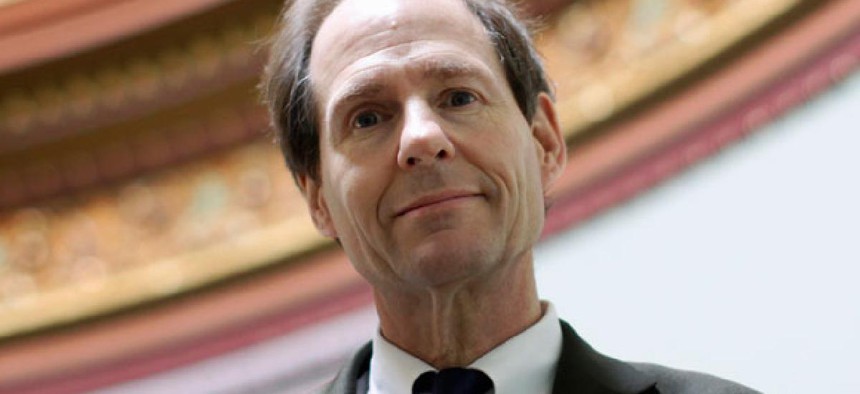Ex-Regulatory Chief Sunstein Touts Obama Accomplishments
Agency rulemakers’ reliance on hard numbers drew critics left and right, he says during book tour.
On a book tour during a break from his new academic post, former Obama administration chief regulator Cass Sunstein on Friday lauded the White House-led “lookback” to eliminate outmoded federal rules as “the most important development” in regulation since the founding of the Office of Information and Regulatory Affairs in the early 1980s.
Speaking at the Brookings Institution, the Harvard University professor who ran OIRA from 2009-2012 said President Obama’s guidance to him when he arrived in Washington from the University of Chicago was to “produce a balanced system, one that is not unprotective but that displays a comprehension of the current economic difficulties.”
The administration’s executive orders mean that cost-benefit analysis and the lookback continue and are “hard-wired into the DNA of the process,” Sunstein said.
His new book, “Simpler: The Future of Government,” offers ways to apply data, technology and uncluttered thinking both to everyday life and to governing. Psychologically, he explained, human behavior can be divided into “System 1” mode, which is “automatic, effortless and fast,” and “System 2,” which is “deliberative, calculated and slow.”
In both practical problem solving and in federal regulation, he argues, more thoughtful, accurate and long-lasting decisions are made through System 2’s cost-benefit analysis, because System 1 thinking relies too often on familiar anecdotes and fails to make the key points salient.
Examples of System 2 thinking in the book range from the Agriculture Department’s heralded update of the confusing old food pyramid to a more intuitive “food plate” graphic, as well as the Transportation Security Administration’s successful use of pre-check programs to reduce airport passenger screening wait times.
In laying out 10 rules for governing simply, Sunstein stressed the harm caused by complexity—the old multipage college financial aid application, for example, before the Obama team streamlined it actually discouraged many families from getting student aid. He also promoted the notion of the “nudge of libertarian paternalism,” which translates to not denying people choices but steering them. Examples include keeping the default setting on an office printer at the cost-saving “print on both sides” option, a presumption of automatic enrollment in employee retirement plans, and Google’s famous campus cafeteria in which healthier foods are displayed the most prominently.
The Obama OIRA’s use of cost-benefit analysis in agency rulemaking, Sunstein said, saved some $90 billion for the economy, compared with only $3 billion under the first three years of George W. Bush’s presidency. This January’s report on the government’s information collection budget, he said, showed that his team had achieved an estimated 100 million hours in burden reduction. “That’s a lookback victory that will make people’s lives better,” he said.
Another proud accomplishment is his office’s requirement that agencies create an executive summary for all major rules, a simplification that helps those outside and inside government, Sunstein said.
Asked about pressures from industry and advocacy groups, Sunstein said his job at OIRA was “mostly internal” and that much of the criticism from businesses on the right or environmentalists on the left were “just outside noise.” He said he had especially collegial relationships with Deputy Agriculture Secretary Kathleen Merrigan; Environmental Protection Agency leaders Lisa Jackson, Robert Perciasepe and Gina McCarthy; National Economic Council Director Gene Sperling; and acting Labor Secretary Seth Harris.
“EPA is very disciplined on cost analysis,” Sunstein said. He praised its rule on fuel economy standards for cars and trucks, its mercury poison protection rule and its rule on “fracking” for gathering underground shale oil, which generally won plaudits from both businesses and activists, he said.
“Consultation with those affected makes compliance easier, so there’s less need for enforcement,” he said. “Government didn’t just slap together that fuel economy rule, nor is it about deference to politically powerful interests, but learning from specialists.”
Though there’s been an “axiom of administrative law that the notice and comment process is just Kabuki theater,” Sunstein said, “under the Obama administration, that couldn’t be further from the truth. If there is a rule that will save, say, 200 lives, and there’s not too much cost, then even if the right calls it a regulatory tsunami, it’s a good rule, and the president is the boss.”
Even when industry lobbyists and public relations specialists produce polls and statistics seeking to discredit proposed rules, “We play regulatory moneyball,” Sunstein said. “The numbers are very important, and the executive order says if the benefits justify the cost, we maximize the benefits.” The cost burden numbers under Obama are down, he noted, and “were created not by political people but by technical people who’ve worked for other administrations. They don’t bear out the idea that Obama went off on some pro-regulatory crusade.”
The next big challenge for governing more simply, he said, is implementation of the Affordable Care Act and setting up the state health insurance exchanges “so they are not overwhelming.”








